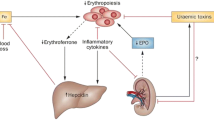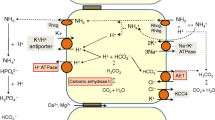Abstract
Purpose. Because the urinary excretion of drugs is often decreased in renal diseases, dosage regimens are adjusted to avoid adverse drug reactions. The aim of present study was to clarify the alteration in the levels of renal drug transporters and their correlation with the urinary drug excretion in renal diseases patients.
Methods. We quantified the mRNA levels of human organic anion transporters (hOATs) by real-time polymerase chain reaction and examined the excretion of the anionic drug, cefazolin, in renal disease patients. Moreover, transport of cefazolin by hOAT1 and hOAT3 were examined using HEK293 transfectants.
Results. Among four hOATs, the level of hOAT1 mRNA was significantly lower in the kidney of patients with renal diseases than in the normal controls. The elimination constant of cefazolin showed a significant correlation with the values of phenolsulfonphthalein test and mRNA levels of hOAT3. The uptake study using HEK293 transfectants revealed that cefazolin and phenolsulfonphthalein were transported by hOAT3.
Conclusions. These results suggest that hOAT3 plays an important role for anionic drug secretion in patients with renal diseases and that the expression levels of drug transporters may be related to the alteration of renal drug secretion.
Similar content being viewed by others
REFERENCES
L. Dettli. Drug dosage in renal disease. Clin. Pharmacokinet. 1:126-134 (1976).
R. Hori, K. Okumura, A. Kamiya, H. Nihira, and H. Nakano. Ampicillin and cephalexin in renal insufficiency. Clin. Pharmacol. Ther. 34:792-798 (1983).
R. Hori, K. Okumura, H. Nihira, H. Nakano, K. Akagi, and A. Kamiya. A new dosing regimen in renal insufficiency: application to cephalexin. Clin. Pharmacol. Ther. 38:290-295 (1985).
J. V. Moller and M. I. Sheikh. Renal organic anion transport system: pharmacological, physiological, and biochemical aspects. Pharmacol. Rev. 34:315-358 (1982).
G. Burckhardt and N. A. Wolff. Structure of renal organic anion and cation transporters. Am. J. Physiol. Renal Physiol. 278:F853-F866 (2000).
K. Inui, S. Masuda, and H. Saito. Cellular and molecular aspects of drug transport in the kidney. Kidney Int. 58:944-958 (2000).
T. Sekine, S. H. Cha, and H. Endou. The multispecific organic anion transporter (OAT) family. Pflugers Arch. 440:337-350 (2000).
M. Hosoyamada, T. Sekine, Y. Kanai, and H. Endou. Molecular cloning and functional expression of a multispecific organic anion transporter from human kidney. Am. J. Physiol. 276:F122-F128 (1999).
R. Lu, B. S. Chan, and V. L. Schuster. Cloning of the human kidney PAH transporter: narrow substrate specificity and regulation by protein kinase C. Am. J. Physiol. 276:F295-F303 (1999).
H. Motohashi, Y. Sakurai, H. Saito, S. Masuda, Y. Urakami, M. Goto, A. Fukatsu, O. Ogawa, and K. Inui. Gene expression levels and immunolocalization of organic ion transporters in the human kidney. J. Am. Soc. Nephrol. 13:866-874 (2002).
A. Enomoto, M. Takeda, M. Shimoda, S. Narikawa, Y. Kobayashi, T. Yamamoto, T. Sekine, S. H. Cha, T. Niwa, and H. Endou. Interaction of human organic anion transporters 2 and 4 with organic anion transport inhibitors. J. Pharmacol. Exp. Ther. 301:797-802 (2002).
S. H. Cha, T. Sekine, J. Fukushima, Y. Kanai, Y. Kobayashi, T. Goya, and H. Endou. Identification and characterization of human organic anion transporter 3 expressing predominantly in the kidney. Mol. Pharmacol. 59:1277-1286 (2001).
D. H. Sweet, D. S. Miller, J. B. Pritchard, Y. Fujiwara, D. R. Beier, and S. K. Nigam. Impaired organic anion transport in kidney and choroid plexus of organic anion transporter 3 (Oat3 (Slc22a8)) knockout mice. J. Biol. Chem. 277:26934-26943 (2002).
E. Babu, M. Takeda, S. Narikawa, Y. Kobayashi, A. Enomoto, A. Tojo, S. H. Cha, T. Sekine, D. Sakthisekaran, and H. Endou. Role of human organic anion transporter 4 in the transport of ochratoxin A. Biochim. Biophys. Acta 1590:64-75 (2002).
Y. Urakami, M. Akazawa, H. Saito, M. Okuda, and K. Inui. cDNA cloning, functional characterization, and tissue distribution of an alternatively spliced variant of organic cation transporter hOCT2 predominantly expressed in the human kidney. J. Am. Soc. Nephrol. 13:1703-1710 (2002).
M. M. Bradford. A rapid and sensitive method for the quantitation of microgram quantities of protein utilizing the principle of protein-dye binding. Anal. Biochem. 72:248-254 (1976).
M. Takeda, S. Narikawa, M. Hosoyamada, S. H. Cha, T. Sekine, and H. Endou. Characterization of organic anion transport inhibitors using cells stably expressing human organic anion transporters. Eur. J. Pharmacol. 419:113-120 (2001).
K. Takahashi, S. Masuda, N. Nakamura, H. Saito, T. Futami, T. Doi, and K. Inui. Upregulation of H+-peptide cotransporter PEPT2 in rat remnant kidney. Am. J. Physiol. Renal Physiol. 281:F1109-F1116 (2001).
A. Takeuchi, S. Masuda, H. Saito, T. Doi, and K. Inui. Role of kidney-specific organic anion transporters in the urinary excretion of methotrexate. Kidney Int. 60:1058-1068 (2001).
L. Ji, S. Masuda, H. Saito, and K. Inui. Down-regulation of rat organic cation transporter rOCT2 by 5/6 nephrectomy. Kidney Int. 62:514-524 (2002).
E. K. Brodwall, T. Bergan, and O. Ørjavik. Kidney transport of cefazolin in normal and impaired renal function. J. Antimicrob. Chemother. 3:585-592 (1977).
G. R. Brown. Cephalosporin-probenecid drug interactions. Clin. Pharmacokinet. 24:289-300 (1993).
M. I. Sheikh. Renal handling of phenol red. I. A comparative study on the accumulation of phenol red and p-aminohippurate in rabbit kidney tubules in vitro. J. Physiol. 227:565-590 (1972).
S. Jariyawat, T. Sekine, M. Takeda, N. Apiwattanakul, Y. Kanai, S. Sophasan, and H. Endou. The interaction and transport of β-lactam antibiotics with the cloned rat renal organic anion transporter 1. J. Pharmacol. Exp. Ther. 290:672-677 (1999).
K. Y. Jung, M. Takeda, M. Shimoda, S. Narikawa, A. Tojo, K. Kim do, A. Chairoungdua, B. K. Choi, H. Kusuhara, Y. Sugiyama, T. Sekine, and H. Endou. Involvement of rat organic anion transporter 3 (rOAT3) in cephaloridine-induced nephrotoxicity: in comparison with rOAT1. Life Sci. 70:1861-1874 (2002).
M. Takeda, E. Babu, S. Narikawa, and H. Endou. Interaction of human organic anion transporters with various cephalosporin antibiotics. Eur. J. Pharmacol. 438:137-142 (2002).
Y. Uwai, H. Saito, and K. Inui. Rat renal organic anion transporter rOAT1 mediates transport of urinary-extreted cephalosporins, but not of biliary-extracted cefoperazon. Drug. Metabol. Pharmacokin. 17:125-129 (2002).
M. Burg, L. Stoner, J. Cardinal, and N. Green. Furosemide effect on isolated perfused tubules. Am. J. Physiol. 225:119-124 (1973).
J. F. Seely and J. H. Dirks. Site of action of diuretic drugs. Kidney Int. 11:1-8 (1977).
Y. Uwai, H. Saito, Y. Hashimoto, and K. Inui. Interaction and transport of thiazide diuretics, loop diuretics, and acetazolamide via rat renal organic anion transporter rOAT1. J. Pharmacol. Exp. Ther. 295:261-265 (2000).
Author information
Authors and Affiliations
Corresponding author
Rights and permissions
About this article
Cite this article
Sakurai, Y., Motohashi, H., Ueo, H. et al. Expression Levels of Renal Organic Anion Transporters (OATs) and Their Correlation with Anionic Drug Excretion in Patients with Renal Diseases. Pharm Res 21, 61–67 (2004). https://doi.org/10.1023/B:PHAM.0000012153.71993.cb
Issue Date:
DOI: https://doi.org/10.1023/B:PHAM.0000012153.71993.cb




